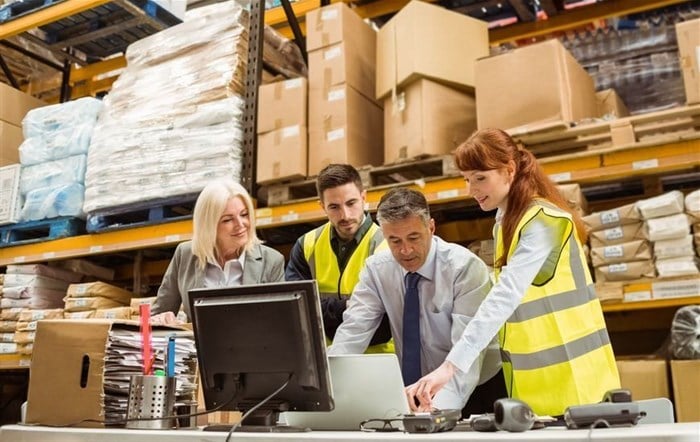Making logistics 4.0 a reality

This is certainly true for logistics. Like many other essential sectors, the industry that moves goods around the world has to leverage data to make better-informed, more strategic business decisions.
The pandemic greatly accelerated the digital transformation roadmap for many companies, in many instances boiling carefully crafted five-year plans into much shorter time spans. But that particular unexpected event isn’t the only driver of digital transformation in the sector.
Perfect storm of change
Three key drivers have converged to create a perfect storm for logistics companies. The first of these is disruptions to the supply chain. The pandemic and its initial stay-at-home lockdowns resulted in a significant uptake of online ordering]] globally, for everything from clothing and electronics to foodstuffs. To address this surge in demand, delivery companies had to significantly expand their headcount, which in turn meant higher costs – something that did not go down well with shareholders.
Quick delivery times became the norm despite the ongoing driver shortages, strikes, increased difficulties crossing borders and wildly fluctuating exchange rates.
In Europe, Brexit on its own added a layer of complexity in new regulations and subsequent increases in costs incurred by the logistics providers. Many of those costs could not be passed on to the consumers.
The second key catalyst of digital transformation is the constant imperative to reduce costs. It is not just driver shortages that tested logistic companies’ business continuity; so too have the soaring fuel shortages, especially since the onset of the war in Ukraine. Furthermore, along with inflation, shipping and freight costs have also risen.
The third key factor is that of the growing power of big data itself.
By 2025, the creation of data globally is projected to grow to more than 180 zettabytes. It cannot be stressed enough that data and by extension analytics, is the fuel of every digitally transformed business and industry.
Collecting, analysing, and leveraging big data is essential if not critical to intelligent decision-making in logistics, especially on the journey to realising the potential of logistics 4.0.
It is also fundamental to practical applications, such as real-time status updates, accurate product tracking and reliable condition monitoring (like air and temperature monitoring) for perishable items.
The problem is that garnering a data-driven holistic view of operations is only possible through the ubiquitous deployment of sensors and Internet of Things (IoT) to capture data across every level of the organisations. However, not every business is able to make that investment. Even those that can do so struggle to collate the data into a single view before overlaying the right analytics and reporting capabilities to deliver actionable insights.
While each of these key points can be addressed with analytics capabilities, there are also five critical roadblocks to digital transformation in logistics that need to be addressed as part of realising logistics 4.0. These include:
#1 The need for connectivity in every location
The innovations of logistics 4.0 require strong, stable and consistent connectivity to underpin their success. This is not a problem in developed regions, but remote areas in Africa or Australia, or those lacking ready access to the needed infrastructure, can find their digitalisation efforts hampered.
#2 Managing data protection
Digitalisation of logistics increases the amount of potentially sensitive customer and stakeholder information stored in the cloud. Complicating matters, companies must be aware of the compliance regulations for each region they’re operating in to avoid breaching the rules. Furthermore, it is critical that employees are trained in best practices to secure their devices and data. For example, organisations need to consider how to protect customer and organisational data if couriers’ handheld devices are lost or stolen.
#3 IoT and supply chain security concerns
The downside to deploying IoT sensors or connecting Operational Technology (OT) to the wider network is that it greatly expands organisations’ attack surface. High-profile attacks on Internet-connected OT systems and IoT, together with concerns over cybersecurity, can make businesses hesitant to take the risks of embracing logistics 4.0.
#4 Disruption and cost of upgrading legacy systems
Many logistics companies rely on legacy infrastructure and use manual processes - like spreadsheets. Upgrading can seem daunting, with fears arising of it being expensive or too disruptive to normal operations. However, failing to digitalise their operations will not only prove more expensive in the long-term, but it will also affect an organisation’s ability to keep pace as competition accelerates.
#5 Support for progressing beyond the pilot stage
The final barrier to digital transformation in logistics is the lack of board-level support. This invariably keeps digital transformation initiatives from progressing beyond the pilot stage. Often this comes from the lack of strong commercial models and clear ways of demonstrating a rapid Return on Investment (ROI).
Future-focused solutions
Even as there are challenges to the digital transformation of logistics, there are also new solutions and maturing technologies that enable innovation. 5G, for example, offers a leap forward in bandwidth and reliability that enables the use of large volumes of data, coming from IoT.
As logistics companies add sensors to the supply chain, 5G will empower them to do intelligent demand planning and preventative monitoring, increasing their efficiencies.
5G will also enable the use of computer vision to facilitate the rapid sorting of incoming and outbound shipments; blockchain technology will be the backbone for creating unique, encrypted signatures for individual products, and in some regions, long-haul self-driving trucks could help address labour shortages. Any of these holds the potential for transforming logistics as we know it.
Enabling digital transformation and making logistics 4.0 a reality and benefitting from all it has to offer is well within reach, but it is not a simple endeavour.
Therefore, the best advice I can give is that operators should look to partner with a reputable solution provider, preferably one that is able to offer strategic advice and a breadth of solutions proven to fast-track digitisation and digitalisation of supply chain operations.